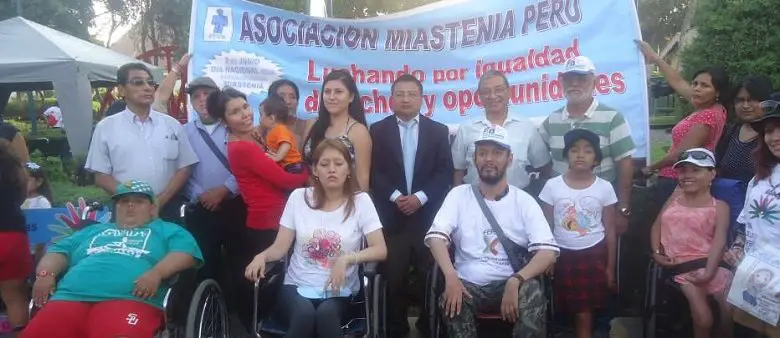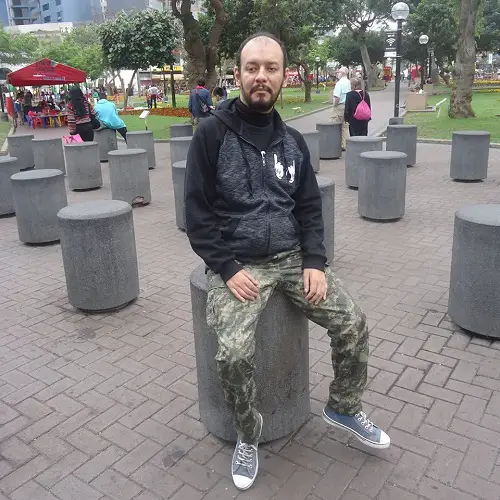
‘I am not lazy!’ Tackling misconceptions around Myasthenia
This is an updated post from our archives. This article shares the personal journey of Carlos Blanch, president and founding member of the Myasthenia Gravis Association in Peru. It highlights his experiences with misdiagnosis, the challenges of living with an invisible illness, and his efforts to raise awareness and support others with myasthenia.
Carlos Blanch is the president and a founding member of the Myasthenia Gravis Association in Peru, as support group for people with the muscle weakening condition. As a result of his own lifelong battle with Myasthenia, Carlos is passionate about supporting others who face the same challenges as him and works to raise awareness and tackle the misconceptions around this rare muscular condition.
Here we follow his personal story and reveal how he and the association is making such a difference to so many people’s lives.
Myasthenia is a rare condition characterised by a group of inherited neuromuscular disorders that cause muscle weakness. It is estimated that around the world, 1 in 100,000 people are sufferers and for the other form of the condition, Myasthenia Gravis, 25 out of every 100,000 people are affected.
Misdiagnosis of the condition has been a longstanding problem, as demonstrated in Carlos Blanch’s own story.
Forty years ago, when he was a baby, his mother was desperately worried that Carlos wasn’t crawling. Doctors told her not to be concerned and that it was not something serious. When he wasn’t walking by the age of three, they mistakenly diagnosed him as having muscular dystrophy and psychomotor retardation. He was subsequently prescribed treatment that failed to help.
It wasn’t until he was six years old when taken to see an opthamologist for a droopy eyelid problem that he was put on the road to a correct diagnosis. Realising that it wasn’t a vision related problem, the opthamologist referred Carlos to a neurologist who finally confirmed that he had congenital Myasthenia.
Myasthenia and the common misconceptions
Symptoms of Myasthenia, which include weakness of the eye and mouth, and feeding and respiratory problems, are not always visible. This leads to many people thinking that sufferers are being lazy, a problem Carlos knows only too well. “On buses or public transport Myasthenia sufferers are often asked to give up a priority seat to someone who is visibly in need because people think we are pretending to be sick so we don’t have to move.”
With these kinds of situations all too common, growing up wasn’t easy for Carlos. I tried to live a normal life but doing simple things proved challenging. At secondary school my symptoms worsened to the point where climbing the stairs was extremely difficult, it took me ages. My classmates noticed my struggle and carried me to the classroom. But playing sports and going to parties was extremely tiring.”
 By the age of 25, Carlos’s condition worsened again. He had to stop commuting by public transport and realising he could not keep up the pace at university, he reluctantly had to give up his dream of becoming an Information Technology engineer.
By the age of 25, Carlos’s condition worsened again. He had to stop commuting by public transport and realising he could not keep up the pace at university, he reluctantly had to give up his dream of becoming an Information Technology engineer.
He remained positive and enrolled at a community college near his home to study graphic design and he now works from home designing websites – a perfect scenario for him.
But it was in 2007, following a particular incident when he was very nearly arrested, that the path of his life moved in a very different direction.
Carlos was on his way to visit his girlfriend when he began to feel very, very weak. Having stopped to lean against a shop wall, he became aware that people were staring at him. Moments later a police car pulled up and the officers informed him that he had been accused of trying to steal from the shop.
Carlos explained his condition but the officers didn’t believe him and after constant questioning he agreed to go with them to the police station. It was only because the officers received an emergency call from elsewhere that they dropped the issue and drove off.
The Myasthenia Gravis Association
The event confirmed Carlos’s frustrations about how little people knew about Myasthenia and he wanted to do everything he could to raise awareness. So, after talking with a group of his friends who also have the condition, they collectively decided to form the Myasthenia Association and Carlos was chosen as leader.
There are now more than 500 registered members to the Myasthenia Gravis Association. Some people sign up to benefit from the free medication for treatment, which was successfully achieved in 2010. Others come because of the community that Blanch has developed, a sentiment endorsed by member Karen Martinez. She says: “Carlos is more of a friend than a leader and the association is a welcoming community where I feel accepted and understood. He inspires members to fight for their rights despite their condition”.
The association runs in part because of the passion of its members. Carlos said: “We are a community running fundraising events such as selling food or raffles, the proceeds of which are used to provide medicines to members in financial difficulties. We don’t receive any donations from laboratories or private institutions. Instead, the members of the community voluntarily donate the pills they get from the health care system. We also make leaflets to help raise awareness as well as organise field trips and fellowship activities.”
Raising awareness of Myasthenia
One of the association’s important aims is to raise awareness around misdiagnosis of Myasthenia, especially because many sufferers die of complications that can be prevented. There have been cases of doctors mistakenly telling people they just had a cold and sending them home, failing properly to diagnose a myasthenic crisis.
Doctor Cristian Carpio, a neurologist and currently a counsellor at the Myasthenia Association in Peru, explains that a myasthenic crisis is a life-threatening condition. He says: “There is a list of medications that people with Myasthenia cannot take, however some doctors, not knowing about the condition, prescribe them to sufferers, thus worsening their condition.”
Carlos and the team at the association work tirelessly to highlight issues such as this and he knows from his own personal struggles that it can be hard to keep motivated. But he is devoted to his role as leader and is helping to develop members of the association to become leaders for the future and take over his work. “I get depressed just as any other Myasthenia sufferer does” says Carlos. “But helping others gives me the strength to keep moving forward.”
He has been writing a blog since 2010 called Disability in Action, to spread the word about people with disabilities and Myasthenia and the challenges sufferers face. The association has certainly moved awareness positively forward with Myasthenia now officially declared as a condition that can cause severe disability, meaning sufferers no longer need to be evaluated in order to get medical leave.
In addition, every June since 2010 there is a Fight Against Myasthenia day, which is undoubtedly a proud achievement for everyone at the association.
Reflecting on his work as an activist and leader of the association, Carlos said: “Life would not have any meaning if I could not help others. I feel satisfied with what I have done and I know that I will be remembered for all my hard work. I can’t stand it when I hear someone has died from Myasthenia because of a wrong diagnosis which is why I cannot stress enough the importance of continuing to raise awareness. For the Myasthenia Association in Peru, this is just the beginning of a very long journey.”
You can find out more about the Myasthenia Gravis Association by visiting the website.
By Esther Bueno
Understanding Myasthenia Gravis: Key Facts
According to the National Institute of Neurological Disorders and Stroke, myasthenia gravis affects approximately 20 out of every 100,000 individuals in the United States.
- Definition: Myasthenia gravis is a chronic autoimmune neuromuscular disorder that causes weakness in the voluntary muscles.
- Symptoms: Common symptoms include drooping eyelids, double vision, difficulty swallowing, and general muscle weakness that worsens with activity and improves with rest.
- Diagnosis Challenges: Due to its rarity and varied presentation, myasthenia gravis is often misdiagnosed, leading to delays in appropriate treatment.
- Management: While there is no cure, treatments such as medications, lifestyle adjustments, and in some cases, surgery can help manage symptoms effectively.
- Support Resources: Organizations like the Myasthenia Gravis Foundation of America provide valuable information and support for those affected.
How to Support Someone with Myasthenia Gravis
- Educate Yourself: Learn about myasthenia gravis, its symptoms, and how it affects daily life. Resources like Myasthenia Gravis Foundation of America can provide valuable information.
- Be Patient: Understand that fatigue and muscle weakness can fluctuate. Avoid judging or pressuring the person to “push through” their symptoms.
- Offer Practical Help: Assist with physical tasks like carrying heavy items, opening jars, or other activities that may be challenging due to muscle weakness.
- Be a Good Listener: Sometimes, just being there to listen without offering solutions can provide emotional support.
- Encourage Rest: Recognize the importance of rest and allow the person to pace themselves without feeling guilty.
- Advocate for Accessibility: Help raise awareness about the need for accommodations in work and public spaces, such as reserved parking or accessible seating.
By taking these small steps, you can help create a supportive and understanding environment for someone living with myasthenia gravis.
Get in touch by messaging us on Facebook, tweeting us @DHorizons, emailing us at editor@disabilityhorizons.com or leaving your comments below.
Originally posted on 03/03/2016 @ 12:30 am